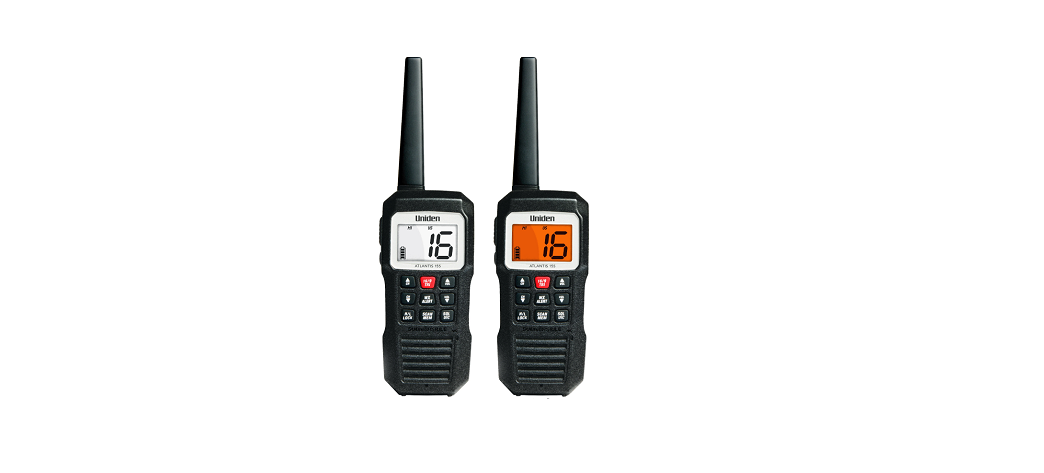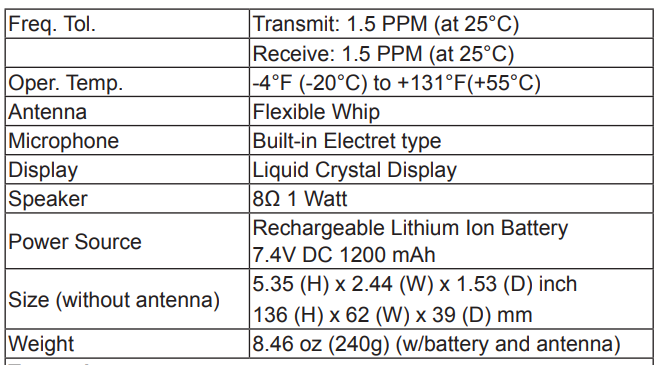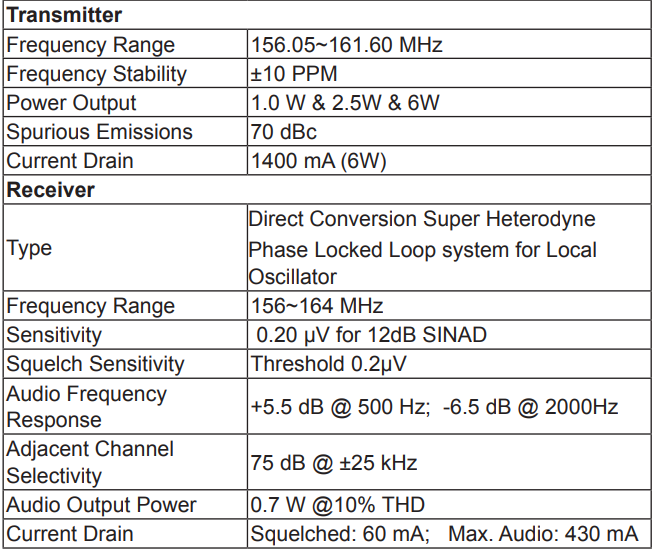
Uniden Atlantis 275 Handheld Two-Way VHF Radio
About Uniden
Uniden America Corporation, the North American subsidiary of Japan-based Uniden Corporation, manufactures and markets wireless consumer electronic products including home security and video security systems, Bearcat® scanners, FRS/GMRS radios, marine radios, radar detectors, dash cams, and other wireless personal communications products. Based in Irving, Texas, Uniden sells its products through retailers and distributors throughout North, Central, and South America.
INTRODUCTION
FEATURES
- Memory scan mode
Lets you save channels to memory and monitor them in quick succession. - Transmit power level select
- Lets you boost the transmitter power from L (Low = 1 Watt) to M (Medium = 2.5 Watts) or H (High = 6 Watts) for added transmission distance.
- Battery level display.
- Battery Save
Unit turns off RX power after 3 seconds without RX or TX. - Dual and Triple operation
These different watch modes let you monitor up to two Coast Guard Distress/Hailing channels along with one regular marine channel. - All marine VHF channels for the U.S., Canada, and international waters
- National Oceanic and Atmospheric Administration (NOAA) Weather Channel watch
Sounds like a warning tone when a hazard alert is issued. - Keylock On/Off
Locks the keys to prevent accidental input. - 10 built-in weather channels.
- Flashlight/Strobe
Turns on a strobe light that flashes in a Morse code SOS pattern or as a solid light (flashlight function). - Backlight
User-selectable white backlight during daylight and amber backlight during night. - Contrast Adjust
Adjust LCD contrast levels. - Vibrating Speaker Tone
Clears water from the speaker cavity. - Emergency CH16/ CH9 Mode
WATERPROOF SPECIFICATIONS
The Atlantis 275 is a submersible radio, that complies with floating IPX8 water-resistant standards. The radio can be submerged in 1.5 meters of water for 30 minutes without damage.
CAUTION! The radio will only meet this rating if fully assembled and all rubber seals are well maintained and correctly fitted. This means that the speaker mic cover must be securely fastened.
After your radio is submerged in water, you might notice that the sound is distorted. This is because there is still water remaining in and around the speaker and microphone. Just shake the radio to clear excess water, and the sound should return to normal. If your radio is exposed to salt water, clean it thoroughly with fresh water and dry it before turning it on. The Atlantis 275 has a special tone that will vibrate the speaker to remove water inside the casing (see page E-18). The charger is not waterproof.
GETTING STARTED
WHAT’S INCLUDED
- Atlantis 275 Radio (Removeable antenna)

- Charger
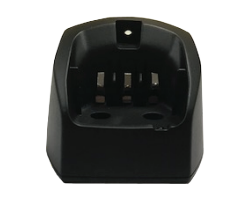
- AC Adapter

- DC Adapter

- Belt Clip
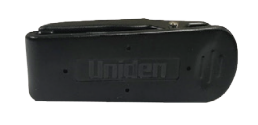
- Mounting Hardware

- Not Shown:
- Hand Strap
- Owner’s Manual
If any pieces are missing or damaged, and for information on accessories, visit www.uniden.com.
PARTS OF THE ATLANTIS 275
Front view
Back view



Charger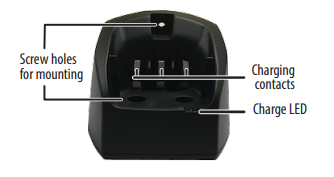
READING THE DISPLAY
The LCD shows different information depending on what you are doing. This sample screen shows some of this information. The table below shows all the possible icons and what they mean.  SETTING UP THE HARDWARE
SETTING UP THE HARDWARE
MOUNTING THE CHARGER
You can mount the charger on any flat surface, horizontally or vertically (horizontal mounting is shown).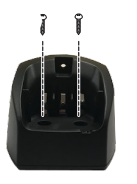
- Use the two holes at the base of the charger as a template to mark the drill holes.
- Using a 1/8-inch (or 3 mm) drill bit, drill two holes 1/2 inch (13mm) deep.
- Use the provided screws to attach the charger to the surface.
CHARGING THE BATTERY
Your radio includes a charger and an internal rechargeable battery. Place your radio in the charger with the display facing forward. Make sure that the CHARGE LED on the charger turns orange.
Cautions:
- Use only the charger supplied with this radio. Using a different charger or battery can damage the radio and create a risk of fire or shock.
- The charger is not waterproof. If the charger falls into the water, unplug it before attempting to remove it from the water. After you remove the charger from the water, visit www.uniden.com for assistance.
- Wipe off dirt or shake water from your radio before placing it in the charger if your radio gets dirty or wet.
Important notes on charging the battery
- Charge the battery fully before using the radio. When the battery is completely charged, the CHARGE LED turns green.
- Don’t use the charger when the ambient temperature is below 41° F (5° C) or above 104° F (40° C).
- If the radio is powered down, the battery can charge in about five hours. (If the radio is powered on, the battery takes longer to charge.)
INSTALLING AND REMOVING THE BELT CLIP
- To install the belt clip:
Slide the belt clip down over the latch until you hear it click. - To remove the belt clip:
-
- Lift the flat latch.
- Slide the clip up until it comes free of the latch.
USING YOUR RADIO
CHANGING THE VOLUME
- To increase the speaker volume, press the VOL SQL key.
- The screen displays VOL and a volume level number. Use the ▲ and ▼ keys to raise or lower the volume. In Volume Setting mode, press the VOL SQL key again to set the volume level and return to the main display. There are 16 volume levels – 0 (mute) to 15.
SETTING THE SQUELCH LEVEL
The squelch feature reduces static on the speaker by filtering out any background channel noise. At the lowest squelch level, the speaker plays all signals, including any channel noise. Setting the squelch level higher filters out noise and lets only actual radio transmissions through.
Note: Setting the squelch level too high may prevent you from hearing weaker transmissions. If you are having difficulty hearing a transmission, try setting the squelch level lower.
CHANGING THE CHANNEL
Press the ▲ and ▼ keys briefly to scroll through the channels one channel at a time. Press and hold the ▲ or ▼ key to quickly scroll through the channels.
MAKING A TRANSMISSION
Select the channel you want to transmit on, then press and hold the Push to Talk key. Release the Push to Talk key when you’re finished talking to let the other party respond.
- To prevent stuck microphone problems or situations where the Push to Talk key is pushed accidentally, the radio limits your talk time to 5 minutes in a single transmission.
- For the best sound quality, hold the microphone about two inches away from your mouth.
- See the channel lists starting on page E-22 for a list of receive-only channels.
Boosting the transmission power
In most situations, the 1-watt transmission power is all you need. If you find yourself far away from other stations and have trouble getting a response, you may need to boost the transmission power from 1 Watt to 2.5 Watts or 6 Watts:
- Select the channel you want to transmit on.
- Press the H/M/L key to switch to the next transmission power level (for example, from 6 Watt to 2.5 Watts; from 2.5 Watts to 1 Watt, or from 1 Watt back around to 6 Watts).
- The display shows the new transmission power in the lower left-hand corner. The transmit power remains at the new setting until you change it again.
Note: Don’t forget to change the transmission setting back to 1 watts when you move close to other stations.
- Some channels (for example, channels 13 and 67) limit the transmission power to 1 watts. When you tune into a limited-power channel, the radio automatically switches to 1 watts. See the channel lists starting on page E-22 for a list of power-restricted channels.
- In an emergency, if you press and hold the Push to Talk switch while briefly pressing the H/M/L key, the power level changes from 1W to 6W.
MAINTENANCE AND TROUBLESHOOTING
Due to its rugged design, your radio requires very little maintenance. However, it is a precision electronic instrument, so you should follow a few precautions:
- If the antenna has been damaged, do not transmit except in an emergency. Transmitting with a defective antenna may cause further radio damage.
- You are responsible for continued FCC technical compliance of your radio.
- You should arrange for periodic performance checks with your Uniden dealer.
COMMON QUESTIONS

SPECIFICATIONS
REGULATIONS AND SAFETY WARNINGS
WARNING! Read this information before using the radio.
MARITIME RADIO SERVICES OPERATION
Warning! This transmitter will operate on channels/ frequencies that have restricted use in the United States. The channel assignments include frequencies assigned for exclusive use of the U.S. Coast Guard, use in Canada, and use in international waters. Operation on these frequencies without proper authorization is strictly forbidden. See pages E-21 through E-26 for tables of the available channels and their uses. If you are still not certain which channels to use, see the FCC maritime radio page at the FCC website (http://wireless.fcc.gov/marine/) or contact the FCC Call Center at 1-888-CALL-FCC. For individuals requiring a license, such as commercial users, you should obtain a license application from your nearest FCC field office (for US users) or Industry Canada (for Canadian users).
BASIC RADIO GUIDELINES
You should familiarize yourself with the rules on marine radios and be aware of which rules apply to your boat. Complete guidelines for all ship and marine radio types can be found at the US Coast Guard website under the topic Radio Info for Boaters (the direct link is http://www.navcen.uscg.gov/marcomms/boater.htm). Here are a few guidelines that affect nearly all boaters.
- If you have a VHF radio on your boat, you must maintain a watch on channel 16 (156.800 MHz) whenever the radio is not being used to communicate. Starting in 2004, if a radio is carried, it must be on and set to channel 16 whenever your boat is underway.
- If you hear a distress call, wait a few minutes to let a shore station or Coast Guard vessel respond. If no other station has responded after 5 minutes, you must respond to the distress call.
- Do not make false mayday or distress calls as a prank or to test your radio. (This is essentially like making a false 9-1-1 call; you may be subject to fines.)
FCC/Industry Canada Information
- Certification: FCC Part 80 or RSS-182
- Output Power: 6W
- Emission: 16K0F3E
- Transmitter Frequency Range: 156.025-157.425 MHz
This device complies with Part 15 of the FCC Rules. Operation is subject to the condition that this device does not cause harmful interference. Unauthorized changes or modifications to this equipment may void compliance with the FCC Rules. Any change or modification must be approved in writing by Uniden. Changes or modifications not approved by Uniden could void the user’s authority to operate the equipment.
FCC RF Exposure Information
In August 1996 the Federal Communications Commission (FCC) of the United States with its action in Report and Order FCC 96-326 adopted an updated safety standard for human exposure to radio frequency electromagnetic energy emitted by FCC-regulated transmitters. Those guidelines are consistent with the safety standards previously set by both U.S. and international standards bodies. The design of the radio complies with the FCC guidelines and these international standards.
- Never allow children to operate the radio without adult supervision and the knowledge of the following guidelines.
WARNING! It is up to the user to properly operate this radio Do not use the radio with a damaged antenna. If a damaged antenna comes into contact with the skin, a minor burn may result.
Body-Worn Operation
This device was tested for typical body-worn operations using the supplied belt clip. To maintain compliance with FCC RF exposure requirements, body-worn operations are restricted to the supplied belt clip. For hand-held operation, the radio should be held 1 inch from the user’s face. The use of accessories that do not satisfy these requirements may not comply with FCC RF exposure requirements and should be avoided. For more information about RF exposure, please visit the FCC website at www.fcc.gov.
Lithium Ion Battery Warning
- This equipment contains an internal rechargeable Lithium Ion battery. The rechargeable Lithium Ion battery contained in this equipment may explode if disposed of in a fire.
- Do not short-circuit the battery.
- Do not use any charger other than the one specified in the owner’s manual to charge the rechargeable battery used in this equipment. Using a different charger may damage the battery or cause the battery to explode.
- Avoid exposing the battery to direct sunlight, heated cars, or temperatures below -4°F (-20°C) or above +140°F (+60°C). Exposing the chemical contained within the battery to temperatures above +140°F (+60°C) may cause the battery to rupture, fail, or reduce performance.
- In case of exposure to the cell contents, wash the affected area thoroughly and seek medical attention.
Three-Year Limited Warranty
- WARRANTOR: UNIDEN AMERICA CORP. (“Uniden”)
- ELEMENTS OF WARRANTY: Uniden warrants, for three years, to the original retail owner, this Uniden Product to be free from defects in materials and craftsmanship with only the limitations or exclusions set out below.
- WARRANTY DURATION: This warranty to the original user shall terminate and be of no further effect 36 months after the date of the original retail sale. The warranty is invalid if the Product is
- (A) damaged or not maintained as reasonable or necessary,
- (B) modified, altered, or used as part of any conversion kits, subassemblies, or any configurations not sold by Uniden,
- (C) improperly installed,
- (D) serviced or repaired by someone other than an authorized Uniden service center for a defect or malfunction covered by this warranty,
- (E) used in any conjunction with equipment or parts or as part of any system not manufactured by Uniden, or
- (F) installed or programmed by anyone other than as detailed by the Operating Guide for this product.
- STATEMENT OF REMEDY: If the product does not conform to this warranty at any time while this warranty is in effect, the warrantor will repair the defect and return it to you without charge for parts, service, or any other cost (except shipping and handling) incurred by the warrantor or its representatives in connection with the performance of this warranty. Some states do not allow this exclusion or limitation of incidental or consequential damages so the above limitation or exclusion may not apply to you.
- LEGAL REMEDIES: This warranty gives you specific legal rights, and you may also have other rights that vary from state to state. This warranty is void outside the United States of America.
- PROCEDURE FOR OBTAINING PERFORMANCE OF WARRANTY: If, after following the instructions in this Operating Guide you are certain that the Product is defective, pack the Product carefully (preferably in its original packaging). Include evidence of the original purchase and a note describing the defect that has caused you to return it. The Product should be shipped freight prepaid, by traceable means, or delivered,
- to warrantor at:
- Uniden America Corporation
- C/O Saddle Creek
- 743 Henrietta Creek Rd., Suite 100
- Roanoke, TX 76262
FAQs About Uniden Atlantis 275 Handheld Two-Way VHF Radio
What distinguishes portable VHF radios from VHF DSC radios?
A DSC handheld radio has a few extra features that make it function just like a typical VHF handheld.
Is long distance VHF usage prevalent?
The only situation in which you should utilize VHF is when you are outside on a field or other open area.
A handheld VHF radio: what is it?
Whether aboard different vessels or working on land in a marina, handheld VHF marine radios provide flexibility in communication for mariners seeking alternatives to fixed-mounted marine radios.
What is the VHF’s entire range?
Whereas UHF radio waves operate in the range of 300 MHz to 3 GHz, VHF radio waves are found in the spectrum between 30 and 300 megahertz (MHz).
Can I use my walkie-talkie on the VHF?
Although it’s true that handheld VHF marine radios shouldn’t be used as walkie-talkies on land, this erroneous information is still being spread despite the fact that these “crimes” have long since passed.
Is GPS required for a VHF radio?
When utilizing the DSC feature on a VHF radio, it is strongly advised to use a GPS receiver. This is a result of the fact that DSC technology is grounded in the present. In the event of an emergency at sea, you must promptly make a DSC distress call and provide the GPS position.
What is the VHF radio’s battery life?
It allows the portable radio to run continuously for up to eight hours. Details: 3000 mAh is the nominal capacity.
What is the longest-range two-way radio?
The POC radio is the walkie-talkie with the greatest range. POC radios have an almost infinite range since they broadcast signals using cellular data. But in order to use them, a subscription is needed.
Why is VHF useful?
A Very High Frequency (VHF) Marine Radio enables instantaneous communication between your boat and other boats, marinas, bridges, and the United States Coast Guard (USCG), while it is not necessary for recreational boats less than 65.5 feet.
Are cell towers used by two-way radios?
Unlike cell phones, two-way radios do not depend on cell towers. They run independently of any other system, radio to radio. 2. In inclement weather or other emergency situations, two-way radios do not rely on telephone lines, which can become overloaded or malfunction.
For more manuals by Uniden Manuals Dock

